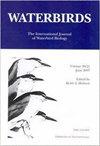野外弃巢后的浅水鸭蛋孵化
IF 0.6
4区 生物学
Q3 ORNITHOLOGY
引用次数: 1
摘要
摘要在大多数鸟类中,亲代孵卵对胚胎发育和存活是必要的。利用每周的巢访、温度数据记录仪、红外摄像机和GPS跟踪母鸡,我们记录了几个被孵蛋的母鸡抛弃后孵出鸭蛋的例子。2015-2019年在加州Suisun Marsh监测的2826个绿头鸭(Anas platyrhynchos)和绿头鸭(Mareca strepera)巢穴中,48个(1.7%)在孵化后期(≥20天)被遗弃。其中,我们确定了6个(12.5%)在遗弃后2-9天内至少有一个蛋孵化。在所有6例中,在巢中发现了蛋壳膜(表明孵化),并在3个巢中观察到雏鸭。被遗弃的鸟巢在蛋孵化前平均有5.9天无人看管;在此期间,巢的平均温度(23.6°C - 29.0°C)大大低于弃巢前(31.7°C - 36.4°C)。我们估计遗弃导致孵蛋完成和孵化之间的时间延长9%(0-4天),鸡蛋孵化成功率降低(36%)。我们的研究结果证明,在温和气候条件下,一些年龄较大的胚胎(≥20天)可以在没有亲本孵育的情况下存活数天,并继续发育(以较低的速度)直至成功孵化。本文章由计算机程序翻译,如有差异,请以英文原文为准。
Dabbling Duck Eggs Hatch after Nest Abandonment in the Wild
Abstract. In most birds, parental incubation of eggs is necessary for embryo development and survival. Using a combination of weekly nest visits, temperature dataloggers, infrared video cameras, and GPS tracking of hens, we documented several instances of duck eggs hatching after being abandoned by the incubating female. Of 2826 Mallard (Anas platyrhynchos) and Gadwall (Mareca strepera) nests monitored 2015–2019 in Suisun Marsh, California, 48 (1.7%) were abandoned during late incubation (≥ 20 days). Of these, we identified six (12.5%) where at least one egg hatched 2–9 days after abandonment. In all six cases, eggshell membranes were found in the nest (indicating hatch), and ducklings were observed at three nests. Abandoned nests were unattended for an average of 5.9 days before eggs hatched; during this time, mean nest temperatures (23.6°C–29.0°C) were substantially lower than before nest abandonment (31.7°C–36.4°C). We estimated that abandonment resulted in a 9% longer time period between clutch completion and hatch (0–4 days longer) and a lower rate of egg hatching success (36%). Our results provide evidence that some older embryos (≥ 20 days) in mild climates can survive without parental incubation for several days and continue to develop (at a reduced rate) to the point of successfully hatching.
求助全文
通过发布文献求助,成功后即可免费获取论文全文。
去求助
来源期刊

Waterbirds
生物-鸟类学
CiteScore
1.30
自引率
0.00%
发文量
0
审稿时长
6-12 weeks
期刊介绍:
Waterbirds is an international scientific journal of the Waterbird Society. The journal is published four times a year (March, June, September and December) and specializes in the biology, abundance, ecology, management and conservation of all waterbird species living in marine, estuarine and freshwater habitats. Waterbirds welcomes submission of scientific articles and notes containing the results of original studies worldwide, unsolicited critical commentary and reviews of appropriate topics.
 求助内容:
求助内容: 应助结果提醒方式:
应助结果提醒方式:


